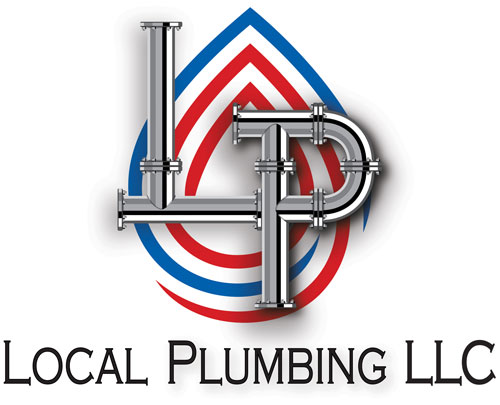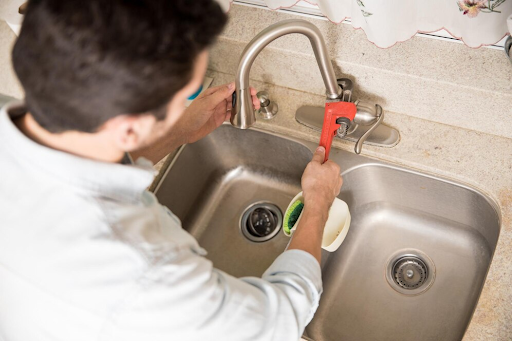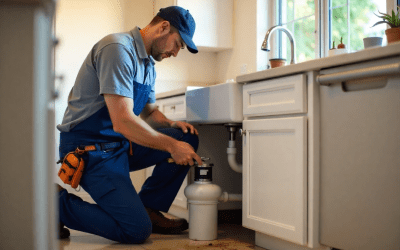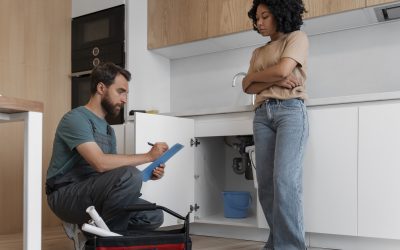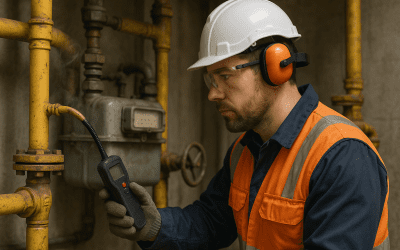Key Kitchen Sink Plumbing Components & Common Issues
Below is an in-depth exploration of the essential components and the technical issues you might encounter.
Faucet Assembly
The faucet is the central delivery point for hot and cold water. Most modern faucets use internal cartridges or ceramic discs to regulate water flow and temperature. Dual-handle faucets have separate valves for hot and cold water, while single-handle models integrate control through a single mixing valve.
Common Issues:
- Persistent Dripping or Leaking: This usually occurs due to worn cartridges, seals, or washers inside the faucet body. Even small leaks can lead to significant water waste over time.
- Irregular Water Flow or Low Pressure: Often the result of mineral buildup in the aerator or clogs within the mixing cartridge. This can affect both hot and cold water lines.
- Water Hammer (Noisy Pipes): Rapid water shutoff can cause pressure shockwaves in the pipes, creating loud banging sounds that indicate unsecured plumbing or high water pressure.
Sink Drain & Strainer Assembly
The sink drain collects wastewater from the sink basin and directs it toward the home’s drainage system. The strainer, usually a basket-style fitting, prevents large debris from entering the pipes.
Common Issues:
- Standing Water or Slow Drainage: Typically caused by a partial blockage in the drain pipe due to grease, food particles, or soap scum accumulation.
- Odors from the Drain: When food particles or organic residue stick to the inner surfaces of pipes, they can decompose and emit foul smells.
- Leaking Around the Strainer Flange: A worn-out plumber’s putty seal or improperly tightened locknut can allow water to escape into the cabinet below.
P-Trap and Trap Arm
The P-trap is a U-shaped pipe beneath the sink that always retains a small amount of water, forming a barrier that prevents sewer gases from entering your home. The trap arm connects the P-trap to the wall’s branch drain.
Common Issues:
- Frequent Clogs: The curve of the P-trap makes it a natural location for grease, coffee grounds, and food waste to collect and harden, causing obstructions.
- Dry P-Trap: Infrequently used sinks can experience evaporation of the water seal, allowing sewer odors to rise into the kitchen.
- Leaks at Joints: Compression or slip-joint fittings can wear down or become misaligned, resulting in slow drips or active leaks.
- Pipe Corrosion: In older homes, metal P-traps may rust or corrode, leading to pinhole leaks or complete failure—one of the more serious kitchen sink plumbing problems to watch for.
Garbage Disposal Unit
A garbage disposal unit mechanically grinds food scraps into fine particles that can safely pass through the drainage system. It consists of a motor, impellers (not blades), a flywheel, and a grinding chamber.
Common Issues:
- Mechanical Jams: Hard items like bones, fruit pits, or silverware can jam the flywheel or impellers, halting operation and straining the motor.
- Motor Hums but doesn’t spin: Indicates a stuck flywheel or a burned-out motor capacitor. This can cause overheating and trip the unit’s internal reset.
- Leaking Disposal Housing: Cracks in the grinding chamber or loose flange seals can result in under-sink leaks that often go unnoticed.
- Unpleasant Odors: Residual food particles stuck in the grinding chamber or drain can rot and create persistent smells.
Water Supply Lines & Shut-Off Valves
These components connect your home’s hot and cold water supply to the kitchen faucet. Shut-off valves, usually under the sink, allow you to isolate the faucet during repairs or emergencies.
Common Issues:
- Leaking or Bursting Supply Lines: Older lines made from rubber or vinyl are prone to wear and can rupture. Modern stainless steel braided lines are more durable but can still develop leaks at the connectors.
- Seized Shut-off Valves: Over time, mineral deposits or corrosion can freeze the valve stem, making it impossible to turn off the water during emergencies.
- Corrosion or Scale Buildup: Copper or brass connectors may develop limescale or rust, weakening the joint and potentially leading to leaks.
- Pressure Drop: Sudden or gradual decreases in faucet pressure can stem from partially closed valves, sediment buildup, or supply line constriction.
When to DIY vs. Call a Professional
Some tasks are perfect for confident homeowners. Others demand licensed expertise, especially when improper handling could result in leaks, structural damage, or code violations.
DIY-Worthy Tasks
- Replacing a Faucet Cartridge: With a bit of research, this is an easy fix for a leaking faucet.
- Unclogging a P-Trap: Just place a bucket underneath, unscrew the trap, and clean it out.
- Replacing Supply Lines: Straightforward swap if valves are functional and accessible.
- Garbage Disposal Reset or Jam Fix: Most units are built with user-friendly reset buttons and jam-clear mechanisms.
Before beginning any kitchen sink plumbing repair under the sink, always shut off the water at the shut-off valves to prevent accidental flooding. It’s also wise to have a few essential tools on hand: a basin wrench for reaching tight faucet nuts, a pair of pliers for fittings, Teflon tape to ensure watertight seals on threaded connections, and a bucket to catch any residual water during disassembly. To make reassembly easier, consider taking clear photos of the existing setup before taking anything apart—this visual reference can save time and confusion later.
When to Call a Professional
- Water Leaks Inside Cabinets or Walls: Hidden leaks can cause mold and structural damage.
- Repeated or Complex Clogs: These might indicate issues deeper in the drain line or an improper pipe slope.
- Garbage Disposal Replacement: If the unit requires electrical rewiring or plumbing modifications.
- Faucet or Sink Upgrade: Especially if you’re switching to a new configuration (e.g., single to double basin or wall-mounted faucet).
- Code Compliance: Any work involving new piping, venting, or drainage rerouting must meet local building codes.
Professionals have access to advanced tools like hydro-jetting systems, in-line camera inspections, and pressure testing equipment that allow them to diagnose and resolve deeper kitchen sink plumbing problems efficiently.
At Local Plumbing LLC, we’re committed to delivering dependable, code-compliant solutions with a personal touch. We also believe in giving back, so we offer exclusive discounts for seniors, making reliable plumbing services more accessible to every household we serve. So, we are just a phone call away if you need a licensed plumber in Schertz or a Plumber in Cibolo. Dial (210) 803-0662 when you need assistance!
